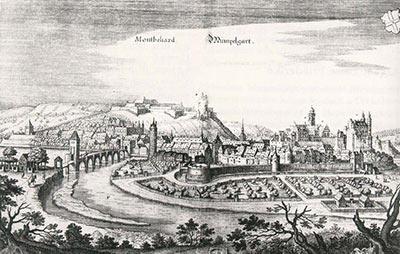The story of the Montbéliard emigrants
Genealogy tourism - the story of our distant cousins is also ours!
In the mid 18th century, cultivation of the land no longer provided enough to feed everyone, especially in what were known as the ‘Villages des Bois’ (the Les Bois villages)’ (seigneuries belonging to Héricourt and Etobon, which were already affiliated to France). In addition, strong religious pressure was exerted in the aforesaid seigneuries. Pastors were replaced by priests and there were murderous ‘dragonnades’ (ill-disciplined troops of dragoons employed by the King to intimidate Huguenot families into converting to Catholicism), as seen at Chagey in August 1740 when the king's grenadiers charged a rioting crowd in front of the Protestant church.
It was into such an environment that a Dutchman by the name of John Dick disembarked on land belonging to Duke Frédéric Eugène of Montbéliard-Wurtemberg in 1748.

He had thousands of hectares of land to distribute (land which had in fact been taken from the Bretons and Normans who had just been expelled by the military from Nova Scotia because of their Catholic faith, known as the Great Upheaval) and the promise of a better future for all those who wished to follow him.
He and his ‘recruiters’ went on to ‘enchant’ thousands of good people in this way and provoked a mass emigration of European Lutherans. Over 3,000 undertook the voyage, including Germans, Swiss and around 431 French Lutherans from the Montbéliard-Wurtemberg area. The average age was 35 and included farmers, weavers, carpenters, thatchers, carters, stonemasons, cobblers and millers, etc. They sold their land and their meagre possessions, and usually made the journey on foot to Basel and up the Rhine to Rotterdam.
It was a long journey (between 2 and 3 months on a boat, via the port of Plymouth in England) which ended in death for many. According to records in Nova Scotia, 1 person from Montbéliard in every 3 died during the first year after their arrival due to the poor conditions during the crossing, as well as the harsh weather on arrival in Halifax, the forced participation in the construction of the Halifax Citadel and false promises about settling there.
It is estimated that over 60,000 inhabitants in Nova Scotia today (Canada) are descended from the original colony from Montbéliard.
A memorial stone commemorating the establishment of this ‘colony’ was erected in Lunenburg in 1988. It bears the names of the 431 people from Montbéliard who arrived on Canadian soil between 1749 and 1752. It is a source of reference for genealogy and collective memory.
These settlers helped to build Lunenburg in Nova Scotia. This town is now listed as a UNESCO World Heritage Site.
The city of Greensboro in North Carolina (USA) welcomed Pierre Lorillard, a native of Montbéliard, in 1749. He founded a cigarette factory there. His descendants are still a part of one of the greatest tobacco brands in America and Montbéliard was twinned with the city in 1964 in recognition of the Lorillard ‘dynasty’.
The Mennonite community in America today counts among its members many farmers whose ancestors left German-speaking Switzerland and passed through the Alsace and Pays de Montbéliard. Their descendants created the Montbeliard breed of cattle! In total, around 1,300 Montbéliard natives of all types left between the end of the 18th century and the end of the 19th century for other countries in Europe , including Russia and the Baltic countries, where they settled. Their descendants can also be found in Minsk in Belarus.














